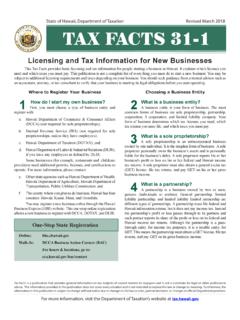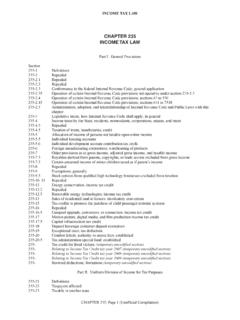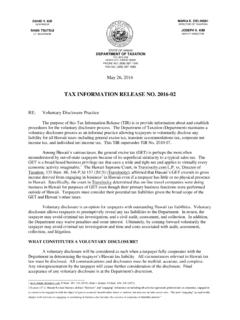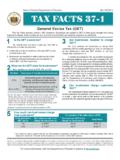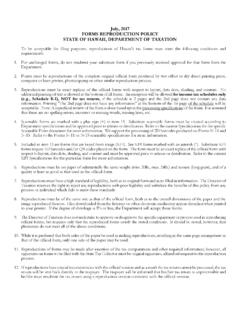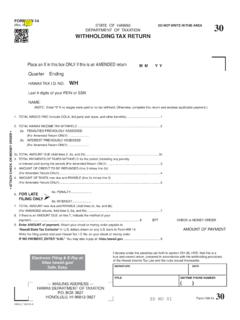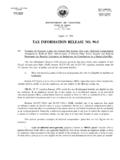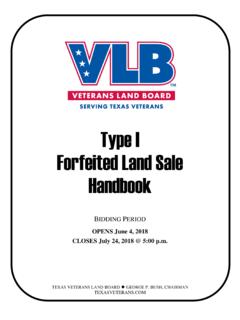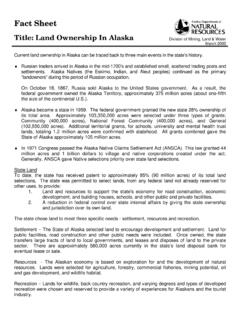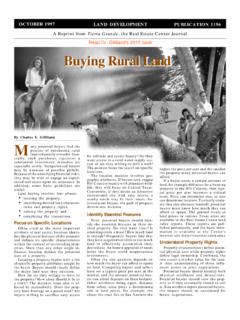Transcription of Land In Hawaii
1 Copyright 2004, RE3 LLC Real Estate Services 1 land IN hawai `I A brief history of the transition from a Feudal System to an Allodial System and Hawaiian words used in real estate in hawai `i today. he first Polynesian voyagers are believed to have arrived in hawai `i some time around 400 Arrivals from Polynesia continued from that time on into the thirteenth and fourteenth centuries. The Hawaiians developed a subsistence culture and they lived close to the land , developing systems and ways to protect, preserve, and restore the ocean and the land resources. The concept of private ownership of property did not exist in hawai `i.
2 The Kings were the sovereign owners of all of the land which was in turn controlled by the ali`i nui or high chiefs and tended or farmed by the kanaka or commoners. This system of land use and control is called a feudal system. Laws and rules, called kapu, were created to prohibit desecration and abuse of resources, both ocean and land . The kapu forbade or prohibited certain practices in order to preserve scarce or limited resources. In this system everyone was entitled to a share of what was produced from the soil or taken from the sea. The land was divided into geographical areas with the divisions intended so that the controlling ali`i and related kanaka had access to a broad spectrum of resources.
3 These land divisions stretched from the ocean to the mountain. Supervision of land under the king was done by the ali`i and decided on the basis of rank. land was held and tended on the condition of obedience of the kanaka and the payment of a share of the produce (taxes). Kanaka occupied land as tenants and only with the continued approval of the ali`i. When an ali`i died the land he supervised reverted to the king. The land divisions were based on geography. The largest land division was an entire island or moku-puni. The largest land unit within the island was the moku, large wedge shaped divisions of land which stretched from the mountain to the ocean.
4 Oahu (approximately 597 square miles) was divided into just six moku. In turn, each moku was divided into narrower strips often running from mountains to the sea. These divisions were called ahupua`a (in reference to the sacrificial pig that marked the boundary) and were governed or supervised by an ali`i. The `ili was next in size and was generally the smaller estate of a chief or konohiki. `Ili were sometimes made up of several pieces of land which were not contiguous or connected. These were called lele or jumps. Smaller units of farm land areas were called mo`o. And finally, the kuleana was the basic land parcel tended by the kanaka.
5 Sizes of units and parcels from ahupua`a to kuleana varied depending upon availability of resources and richness and fertility of the area. Boundaries separating the various divisions and units were geographical in nature and the system made use of mountains, gullies, rivers and other natural points or features of demarcation. Where natural boundaries did not exist, stone walls often marked boundaries and many of these walls can still be seen today. Directions were generally given based upon the location of the person giving the directions. Standing on the shore facing inland, the direction was uka or mauka.
6 T Copyright 2004, RE3 LLC Real Estate Services 2 Standing inland and facing the sea, the direction was kai or makai to indicate going in a seaward direction. North was luna or up and south was lalo or down. Frequently, rather than referring to compass directions, the person giving the direction would refer to place names instead. This practice continues today with locals often saying to proceed towards Ewa or towards Diamond Head or beyond to Koko Head , for example. Different island s kings sometimes fought battles for control of territory. In the 1790 s Kamehameha the Great emerged as victor and by 1796 he had conquered all islands except Kauai and brought them under his rule.
7 For the first time, hawai `i was united and ruled by a single king. He distributed land to the ali`i and konohiki to control and oversee. They in turn distributed land to the kanaka. However, no one owned the land and at death a parcel or unit was returned to the overseer for redistribution. Essentially, the king could distribute land to anyone he wanted if he so chose. In 1778 Captain Cook reached the Hawaiian Islands and not long after missionaries and businessmen followed. With them came the ways of the western world and ideas of trade consistent with a market economy. Under the influence of the western civilization, concepts of private property began to emerge.
8 In 1839 the Bill of Rights of the Hawaiian Islands was enacted which guaranteed that people s lands would not be taken from them. In 1840, the first Constitution of hawai `i was enacted. This constitution made it clear that people had an interest in land greater that that of the bounty and produce of the land . In 1845, the land Commission was created in hawai `i by Kamehameha III to award land claims. However, it was not able to do so because the feudal system of land tenure still existed and individuals did not hold title to land . The Great Mahele (great land division) occurred in 1848. The King and 245 ali`i and konohiki came together to divide the land .
9 In a process that took several months, the land was divided into three classifications. Of the approximate four million acres in hawai `i, the king reserved one million acres for himself and his family. These were called crown lands. Of the remaining three million acres, approximately half were designated as Government Lands and the other half was given to the ali`i and konohiki and which became known as Konohiki Lands. The record of the distribution of lands in the three classifications was set forth in the Mahele Book. The Great Mahele is the single most important event in the history of land title in hawai `i.
10 It essentially abolished the feudal system and gave rise to an allodial system of land tenure. Private ownership of most of the property in hawai `i began with the Great Mahele. Crown, Government and Konohiki lands remained subject to the rights of the kanaka who were often in possession and cultivating the lands. As land sales by King Kamehameha III, the government and the ali`i and konohiki took place, the rights of the kanaka in possession became an issue. In 1850, it was decided that the land Commission could award title of land to kanaka who remained in possession (physically occupied) and cultivated or improved Copyright 2004, RE3 LLC Real Estate Services 3 any portion of the Konohiki Lands.
